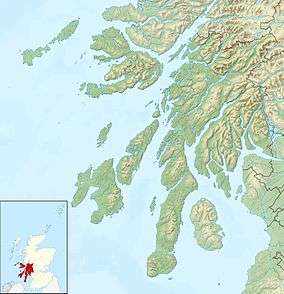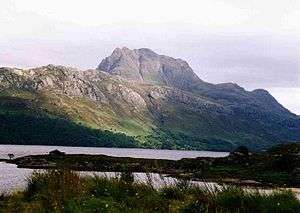Ben More (Mull)
Ben More (Scottish Gaelic: Beinn Mhòr, meaning "great mountain") is the highest mountain and only Munro (mountains in Scotland that reach an elevation of 3,000 feet (910 m) or more) on the Isle of Mull, Scotland.
| Ben More | |
|---|---|
| Beinn Mòr | |
.jpg) Ben More from the shores of Loch na Keal | |
| Highest point | |
| Elevation | 966 m (3,169 ft) [1] |
| Prominence | 966 m (3,169 ft) Ranked 7th in British Isles |
| Parent peak | none - HP Mull |
| Listing | Marilyn, Munro |
| Coordinates | 56°25′29″N 6°00′48″W |
| Naming | |
| English translation | Big mountain |
| Language of name | Gaelic |
| Pronunciation | Scottish Gaelic: [ˈpeiɲ ˈvoːɾ] |
| Geography | |
 Ben More | |
| OS grid | NM525330 |
| Topo map | OS Landranger 47, 48 |
It is the highest peak in the Inner Hebrides apart from those on the Isle of Skye. The mountain is situated in the south of the island, above the shores of Loch na Keal.
Access and climbing route
The peak is easiest reached from Loch na Keal, the walk up from the B8035 road following farm tracks, the side of a stream; Abhainn Dhiseig, and ultimately up scree slopes to the top. From the summit on a clear day, the view encompasses the Sound of Mull, Staffa, Ulva, the Ross of Mull and Iona in the distance. From sea loch to summit is approximately a four-hour walk.
The more demanding but rewarding route follows a boggy path up the banks of Abhainn na h-Uamha to the bealach between A' Chìoch ("The Breast") and Beinn Fhada (not to be confused with its namesake in Kintail). From the bealach the route follows South West along a steep and rocky ridge first to the peak of A' Chìoch then on and up to Ben More itself. There is respite at the top in a circular refuge of stones. This route starts and ends on the B8035 road and is approximately a 6-hour walk and scramble.
Climbers should be cautious when using a compass in misty conditions since there is magnetic rock in places, especially near the summit of the mountain.[2]
Geology
Around 60 million years ago, the region was volcanically active, with Ben More being the remnant of a volcano, and it was in this period that the famous rock formations of Staffa and the basaltic columns of "The Castles" on Ulva came into being.[3] The lava flows are known as the "Staffa Magma Type member" and can also be seen on Mull at Carsaig, Ardtum, and near Tobermory on its east coast. They are particularly rich in silica.[4]
See also
References
- "Ben More (Mull)". walkhighlands.co.uk. Retrieved 13 October 2013.
- "Ben More the Mountain of the Eagles". Ardoran House. 2016-07-22. Retrieved 2020-08-17.
- "Ulva — Geology". The Isle of Ulva — A world apart. Archived from the original on 2011-08-15. Retrieved 2007-11-05.
- "Mull-Staffa". Scottish Geology Website. Hunterian Museum. Archived from the original on 2007-12-01. Retrieved 2007-11-05.
External links
| Wikimedia Commons has media related to Ben More. |





